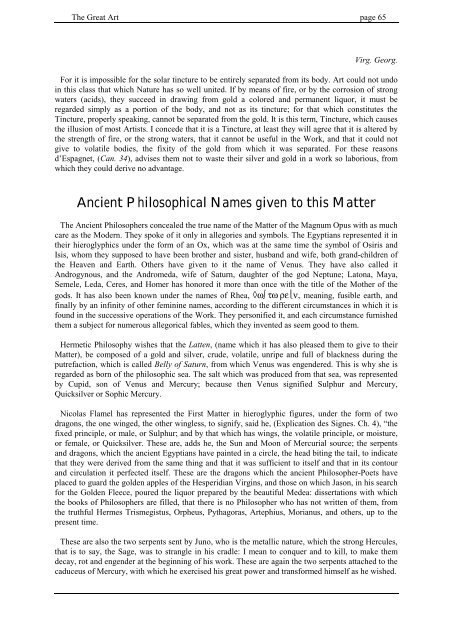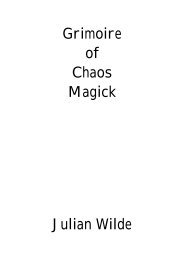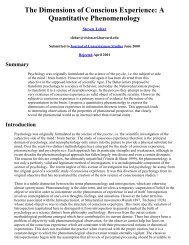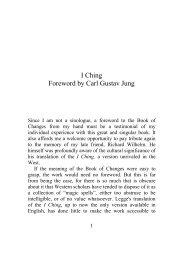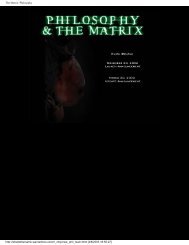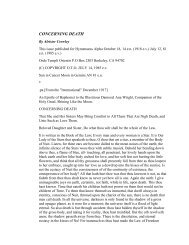Pernety - A Treatise On The Great Art.pdf - cyjack.com
Pernety - A Treatise On The Great Art.pdf - cyjack.com
Pernety - A Treatise On The Great Art.pdf - cyjack.com
Create successful ePaper yourself
Turn your PDF publications into a flip-book with our unique Google optimized e-Paper software.
<strong>The</strong> <strong>Great</strong> <strong>Art</strong> page 65Virg. Georg.For it is impossible for the solar tincture to be entirely separated from its body. <strong>Art</strong> could not undoin this class that which Nature has so well united. If by means of fire, or by the corrosion of strongwaters (acids), they succeed in drawing from gold a colored and permanent liquor, it must beregarded simply as a portion of the body, and not as its tincture; for that which constitutes theTincture, properly speaking, cannot be separated from the gold. It is this term, Tincture, which causesthe illusion of most <strong>Art</strong>ists. I concede that it is a Tincture, at least they will agree that it is altered bythe strength of fire, or the strong waters, that it cannot be useful in the Work, and that it could notgive to volatile bodies, the fixity of the gold from which it was separated. For these reasonsd’Espagnet, (Can. 34), advises them not to waste their silver and gold in a work so laborious, fromwhich they could derive no advantage.Ancient Philosophical Names given to this Matter<strong>The</strong> Ancient Philosophers concealed the true name of the Matter of the Magnum Opus with as muchcare as the Modern. <strong>The</strong>y spoke of it only in allegories and symbols. <strong>The</strong> Egyptians represented it intheir hieroglyphics under the form of an Ox, which was at the same time the symbol of Osiris andIsis, whom they supposed to have been brother and sister, husband and wife, both grand-children ofthe Heaven and Earth. Others have given to it the name of Venus. <strong>The</strong>y have also called itAndrogynous, and the Andromeda, wife of Saturn, daughter of the god Neptune; Latona, Maya,Semele, Leda, Ceres, and Homer has honored it more than once with the title of the Mother of thegods. It has also been known under the names of Rhea, ◊ω∫ τω ρε⎩ν, meaning, fusible earth, andfinally by an infinity of other feminine names, according to the different circumstances in which it isfound in the successive operations of the Work. <strong>The</strong>y personified it, and each circumstance furnishedthem a subject for numerous allegorical fables, which they invented as seem good to them.Hermetic Philosophy wishes that the Latten, (name which it has also pleased them to give to theirMatter), be <strong>com</strong>posed of a gold and silver, crude, volatile, unripe and full of blackness during theputrefaction, which is called Belly of Saturn, from which Venus was engendered. This is why she isregarded as born of the philosophic sea. <strong>The</strong> salt which was produced from that sea, was representedby Cupid, son of Venus and Mercury; because then Venus signified Sulphur and Mercury,Quicksilver or Sophic Mercury.Nicolas Flamel has represented the First Matter in hieroglyphic figures, under the form of twodragons, the one winged, the other wingless, to signify, said he, (Explication des Signes. Ch. 4), “thefixed principle, or male, or Sulphur; and by that which has wings, the volatile principle, or moisture,or female, or Quicksilver. <strong>The</strong>se are, adds he, the Sun and Moon of Mercurial source; the serpentsand dragons, which the ancient Egyptians have painted in a circle, the head biting the tail, to indicatethat they were derived from the same thing and that it was sufficient to itself and that in its contourand circulation it perfected itself. <strong>The</strong>se are the dragons which the ancient Philosopher-Poets haveplaced to guard the golden apples of the Hesperidian Virgins, and those on which Jason, in his searchfor the Golden Fleece, poured the liquor prepared by the beautiful Medea: dissertations with whichthe books of Philosophers are filled, that there is no Philosopher who has not written of them, fromthe truthful Hermes Trismegistus, Orpheus, Pythagoras, <strong>Art</strong>ephius, Morianus, and others, up to thepresent time.<strong>The</strong>se are also the two serpents sent by Juno, who is the metallic nature, which the strong Hercules,that is to say, the Sage, was to strangle in his cradle: I mean to conquer and to kill, to make themdecay, rot and engender at the beginning of his work. <strong>The</strong>se are again the two serpents attached to thecaduceus of Mercury, with which he exercised his great power and transformed himself as he wished.


